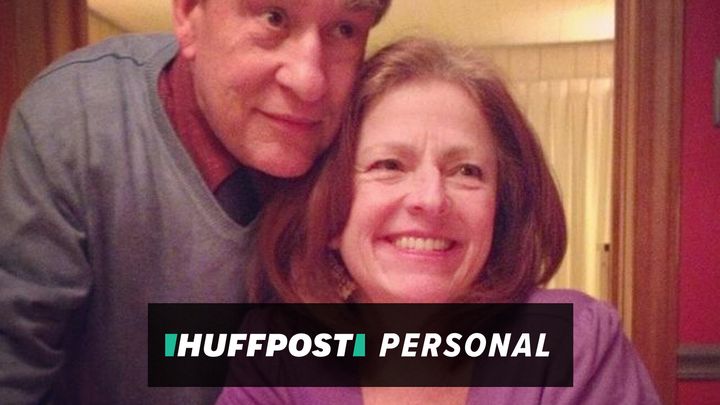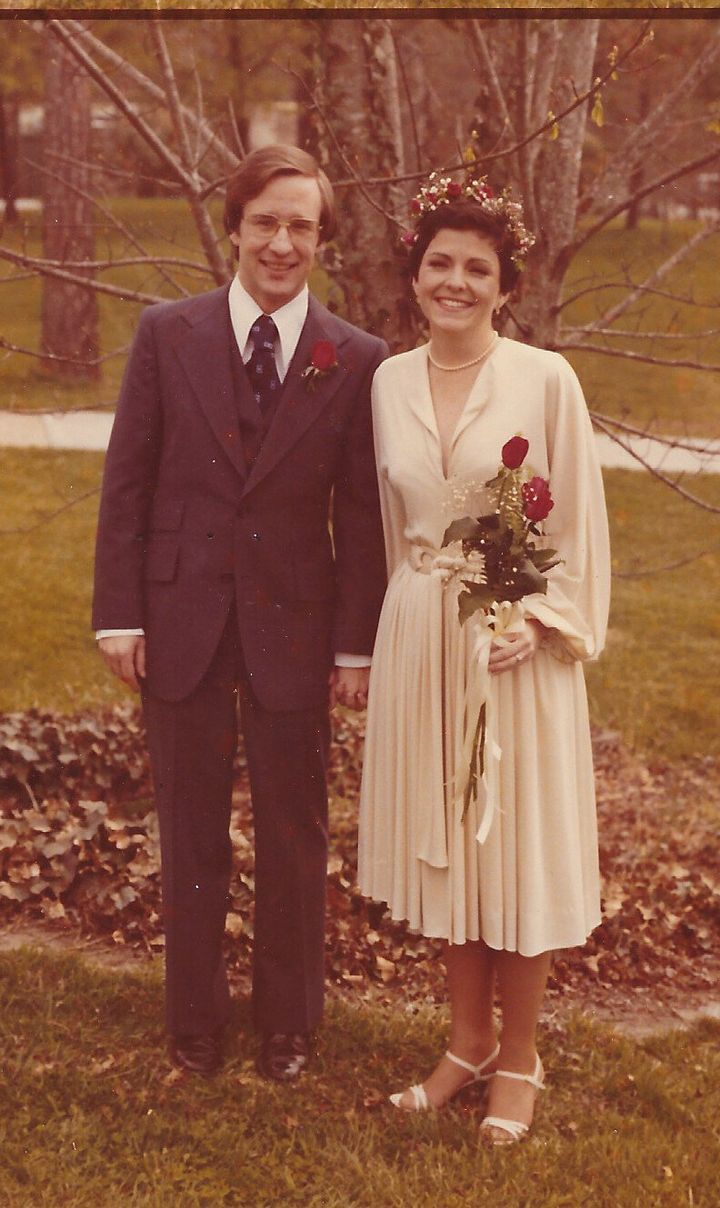
(I)
I was 17 when Steve and I got engaged, and just 20 when we married. Looking back now at my tender age and the 0-to-60 mph speed of our courtship leading up to that diamond ring, I see hints of the mania that would upend my life three decades later. I was in a huge hurry to get through ― and past ― my teens and into a grown-up marriage. Impulsively, I said “I do” to my first real boyfriend and “I don’t” to what had been a chaotic and mostly unhappy childhood. All I wanted was some peace and order. I found both in Steve, and I felt happy and rescued.
Once the honeymoon was over, I settled down to a comfortable, drama-free existence. I had never been a fashionista, but during my first few decades as a wife, to say I dressed modestly would be an understatement. When I wasn’t in maternity wear (which, with five babies in 10 years, I often was), I favored the kinds of sweatshirts and T-shirts that trumpeted the next holiday (jack-o’-lanterns! dancing Santas!), paired with dowdy mom jeans or Bermuda shorts.
Though I worked as an actress, I was a children’s theater performer living just outside Philadelphia, so no one expected me to wear anything spandex or to teeter around in stiletto heels. I blended right in, driving my beat-up Chevy Celebrity wagon in the elementary school carpool line.
At home, Steve and I had a very affectionate partnership, without noticeable fireworks. After all, we had five young children to corral. We had traded our disco nights for 9 p.m. bedtimes. What I remember most about those years was a deep sense of contentment. My parents had never found happiness, bickering incessantly for nearly 40 years, and my two sisters and I were keenly aware of the sadness underlying their union ― and our lives. It was amazing to be able to argue with my husband, briefly and occasionally, about inconsequential things and never once fear for our marriage.
“What I remember most about those years was a deep sense of contentment.”
And so it went, until my late 40s. Our children grew up. Their playdates became real dates, and the scribbled drawings on the refrigerator were swapped for high school essays. When I bothered to look in the mirror, I noticed that gray hairs had appeared, as had a few wrinkles — neither of which I did anything about. While perhaps a bit boring, it was the life I had gladly chosen, and I anticipated it continuing well into the future.
(II)
But everything was about to change. At 48 I entered menopause and accompanying the hot flashes were strange, intense new feelings. I suddenly hated being me ― or at least the me who had settled for what now seemed like a ridiculously humdrum existence. With the flip of a switch, I morphed into the ultimate party animal.
I dyed my hair, grew out the sensible haircut and started piling on the makeup. I was ready for anything ― anytime, anywhere. “Let’s go dancing!” I suggested almost nightly (or “anywhere I can wear my leather miniskirt!”). I was thrilled at the sight of my sexy self in the mirror I now so loved to gaze at, and I wanted to go out and paint the town, even on Tuesdays.
It must have seemed to Steve that his wife had, almost overnight, been switched out for a very different model. And he wasn’t sure what to make of me. I wasn’t sure what to make of myself, but at that point, I didn’t care. At first, I think my husband was intrigued by his “new” spouse — after all, no one would say that my former, rather frumpy look was really enticing. But it wasn’t long before his fascination with my new glam persona was tinged with fear about my recklessness. I would go from kissing him to cursing him (and back again) within minutes.
He rarely took the bait when I attacked him, but I know he was angry and hurt. Those fireworks ― the ones that had been absent from our union for years ― were now a constant display of bottle rockets and Roman candles close enough to burn. Our children were older now, several off to college, one studying in Thailand. I was able to hide my more extreme behavior from my faraway offspring effectively (though thinking back, I wonder how effective I truly was). On the home front, only Steve and our two youngest children were there to witness my explosions. The kids were on the receiving end of many obscenity-filled rants about nothing, and I am sure they were frightened. Only Steve had to deal with my hypersexuality, which I imagine drew him and repelled him at the same time.
“I suddenly hated being me ― or at least the me who had settled for what now seemed like a humdrum existence. With the flip of a switch, I morphed into the ultimate party animal.”
As the months went by, it became more difficult to control my moods. I would sail around the house, utterly euphoric, singing and scribbling down an endless succession of what I considered to be brilliant ideas. Hours later, I’d close the door of my office at work, put my head on my desk and sob. I remember hatching an absurd plan to drive eight hours round trip in one evening to bring a drummer down to play a gig with my son’s band in Washington, D.C. (which my son had not asked me to do).
I bailed on our annual New Year’s family bowling outing and several obligations with my youngest daughter’s school because my torrents of tears did not stop. Yet if you’d asked me if I thought I was sick, I would have bitten your head off. Sick? No! I was alive, in a way I had never been before, and (when I was manic) I loved it. I was awake 20 hours a day and felt super productive.
But the lack of sleep was taking its toll. Over time, the thrilling highs were less frequent, replaced by longer bouts of dull depression.
(III)
Finally at 49, exhausted and frantic after a year of suffering, I reached my limit. Over tea, a good friend gently encouraged me to seek help, and I picked up the phone at last. I saw a psychiatrist and was diagnosed with bipolar disorder. I had just read an ad for antipsychotic medication in a magazine, and the symptoms listed there were precisely my own, so I wasn’t terribly surprised to get this news. But it was still very painful to hear.
There were no guarantees that I would improve quickly ― and indeed the first few meds I took did no good whatsoever. I was horrified to think of myself as mentally ill. I thought of it as a life sentence with a disease that was both misunderstood and stigmatized. At the same time, I was relieved to discover the cause of my bizarre transformation.
It took months, several different medications and a change of doctors before I saw much improvement. It was very hard to talk about my experience with a psychiatrist (or anyone for that matter). I was so ashamed and hated reliving the terrible times in my mind. At first, I spent many of my appointments not talking, just crying. I had never known anyone else with bipolar, and I had a lot to learn.
“I thought of it as a life sentence with a disease that was both misunderstood and stigmatized. At the same time, I was relieved to discover the cause of my bizarre transformation.”
I discovered that the average age of onset for bipolar disorder is 25, though the majority of people with it are originally misdiagnosed. It’s also possible for the onset to come later in middle age and there may be a hormonal trigger ― possibly explaining the emergence of my illness coinciding with the start of menopause. And while there is no cure, symptoms can be managed, so that people with bipolar can lead normal, fulfilled lives.
Even after I found the doctor and combination of medications that made all the difference, it was still a bumpy, painful road to recovery. As a person of faith, I prayed a lot but kept feeling a Divine disappointment in me. Steve had quietly paid the bills when at my worst, I’d maxed out the charge cards with impulse purchases from Bloomingdale’s, month after month. He was now juggling our tight budget in order to afford my weekly therapy appointments and my buffet spread of pills ― and he never once complained.
I had to face the many people I’d treated shabbily, which included my closest family members, and try to make amends. At that point, I wanted to be rejected. I deserved to be rejected. Instead, I received nothing but unconditional love from everyone, most of all from my husband. Steve never blamed me or judged me. He was just clearly happy to have his wife back. Would I have felt the same if the tables were turned and Steve was the sick one, putting me through hell? I don’t honestly know. I hope so. I’d like to think so.

(IV)
Twelve years down the road, the curtain has risen on our marriage as it is today. I am 62 now, well past the mania and the blues and the profane rages. I continue with therapy and medication, aware that I still need both to function normally. My clothes closet is much less colorful, my hemlines a good bit longer and my necklines much higher. I am a pretty conservative dresser once more (though I will never wear a Santa sweatshirt again). It has been ages since I last picked a fight or swore or felt that out-of-control adrenaline rush.
All of our kids are grown, and we have two grandkids. Once again, thanks in large part to Steve, there is peace and order in my life. The contentment I had never had as a child but found in my early marriage is with me now. I am aware of how hard-won this feeling is, and I will never again take it for granted. This is probably our final act as a couple, though I hope it will be a long one.
This article first appeared on HuffPost US Personal
Have a compelling personal story you want to tell? Find out what we’re looking for here, and pitch us on ukpersonal@huffpost.com